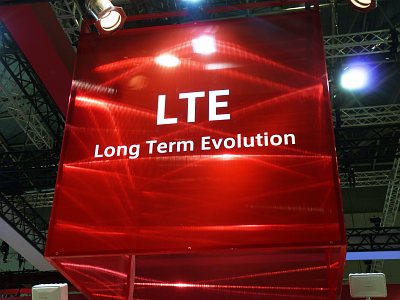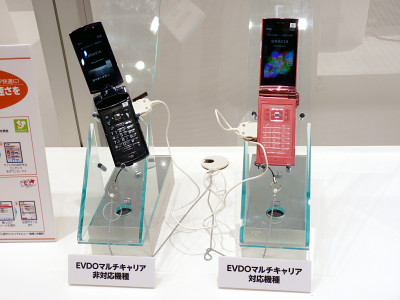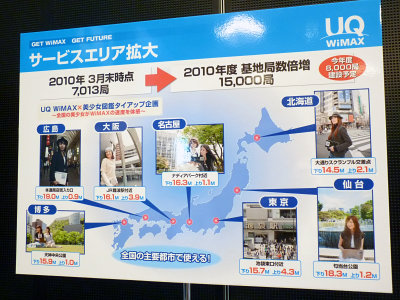DoCoMo starts on March 27 on "PREMIUM 4G" of the fastest 225 Mbps in Japan, in which the file DL speed exceeds 1.5 times the LTE

Currently used LTE technology is strictly called 3.9 G, but the fourth generation (4 G) mobile phone standardLTE-Advancedservice"PREMIUM 4GIt will finally start DoCoMo from March. Since the LTE-Advanced reporter briefing to improve the speed by overlapping multiple LTE bands and using them simultaneously was done at the docomo lounge, we have been going through to see what kind of service it is.
LTE-Advanced | Corporate Information | NTT DoCoMo
https://www.nttdocomo.co.jp/corporate/technology/rd/tech/4g/
For reporters Briefing sessions & experiences sessions will be held at the docomo lounge on the 1st floor of the New Yurakucho Building.

Before the start time, before the DoCoMo lounge it was already full of press.
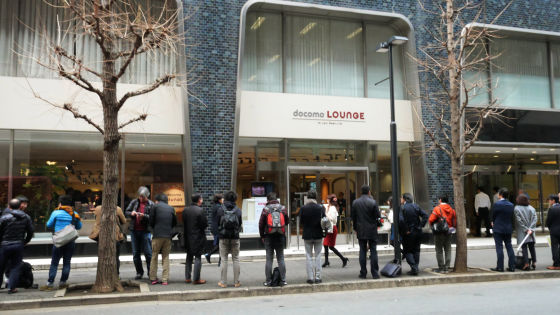
When entering and entering, the inside looks like this.
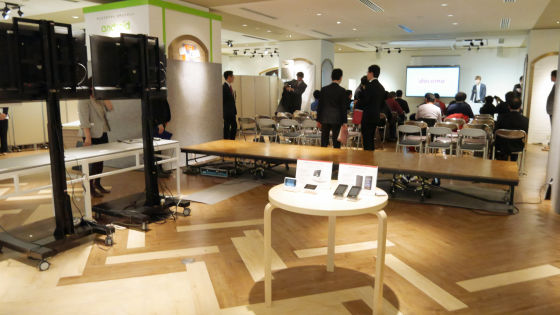
Wi-Fi STATION H-02G "released on February 18, LTE-Advanced compatible router" Wi-Fi STATION L-01G "released in March was arranged side by side.
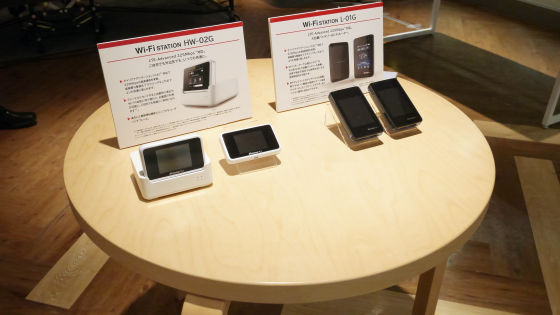
People are steadily increasing in the hall ... ...

Starting a briefing session.
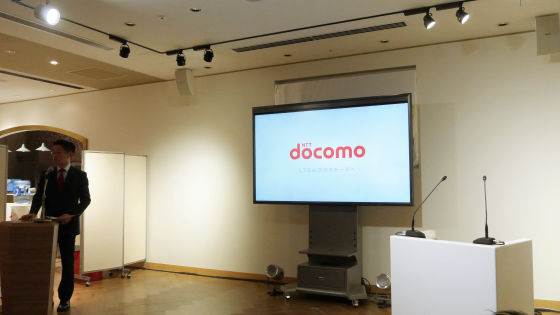
Mr. Kiyohiro Matsuzawa, Managing Executive Officer and Director of NTT Docomo, appeared.
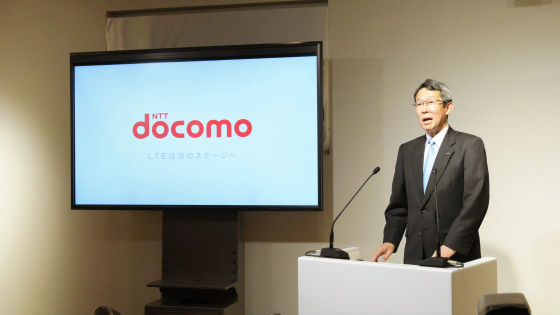
DoCoMo will start a new service in March LTE-Advanced service name is "PREMIUM 4G"
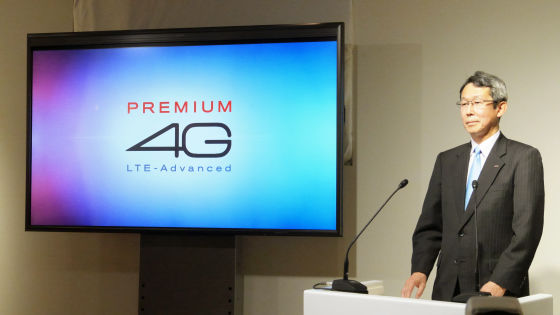
In order to pursue further "speed" and "comfort", DoCoMo has developed a technology called "carrier aggregation" that overlaps multiple frequency bands and a technology called "add-on cell" that installs a small cell base station in a micro cell base station "Advanced C - RAN" using LTE - Advanced enabled.
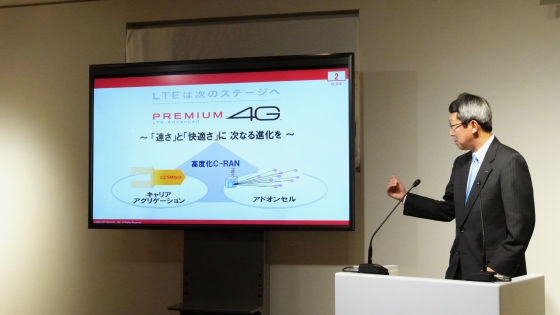
There are two types of carrier aggregation that DoCoMo carries out, one that realizes 225 Mbps by overlapping the 1.5 GHz band and the 112 GHz band of 112.5 Mbps and the other one that achieves 225 Mbps by overlapping the 800 MHz band of 75 Mbps and the 1.7 GHz band of 150 Mbps Those that realize.
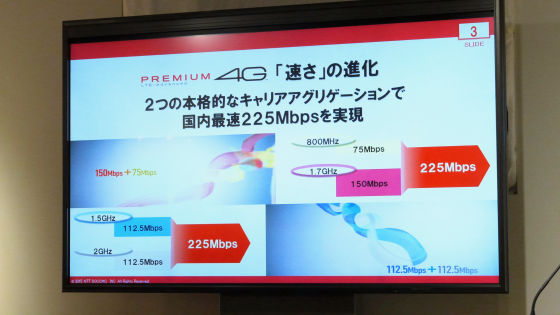
The file download time of PREMIUM 4 G is shortened to 60% compared with LTE. If you download about 400 MB of video, it takes 34 seconds to complete it in 20 seconds.
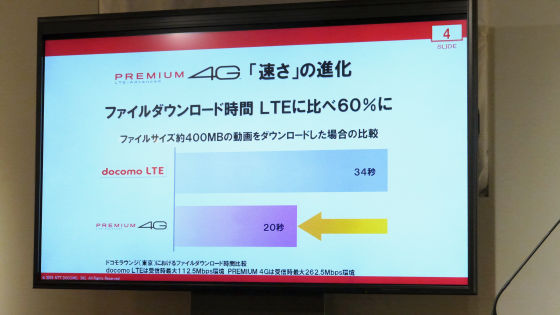
Also, by using add-on cells, increase the wireless capacity in areas where traffic concentrates.
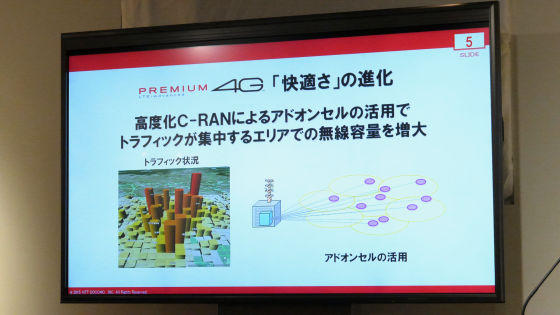
The execution speed in places where traffic concentrates in urban areas is increased by 70% in LTE ratio.
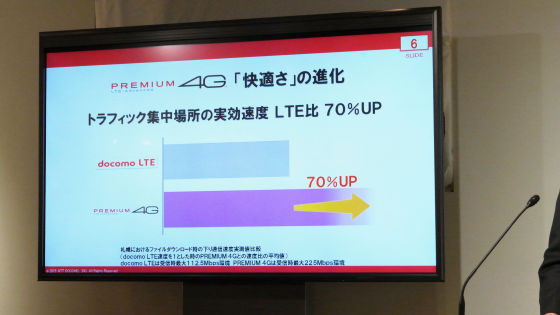
The field test was conducted in commercial environment from November 2014.
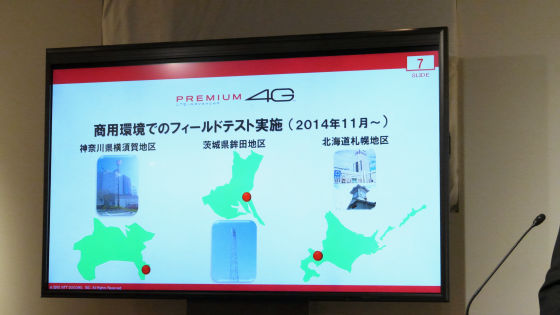
The service starts from March 27. The briefing session & experiencing society was held on February 25, about the timing of about 1 month before the service started and 225 Mbps. Area development will be intensively made from urban areas of 38 cities in 22 prefectures nationwide.
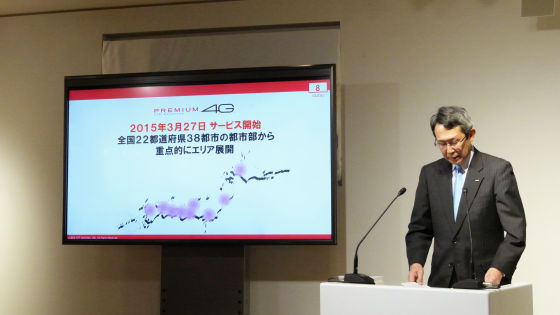
By using add - on cell, comfort at traffic concentration place will increase, so in Tokyo it will develop from the main station of JR Yamanote line in order.
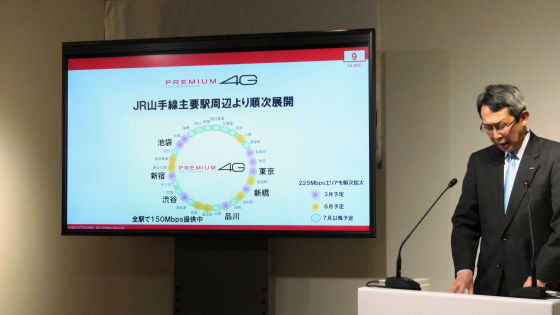
Currently LTE-Advanced is compatible with the Wi-Fi STATION HW-02G router released on February 18 and the Wi-Fi STATION L-01G released in March, but in 2015 We plan to announce PREMIUM 4G compatible smartphones as soon as possible.
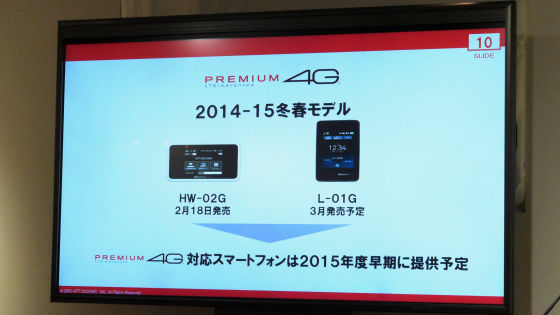
LTE-Advanced Corporate Experience Event will be held ......
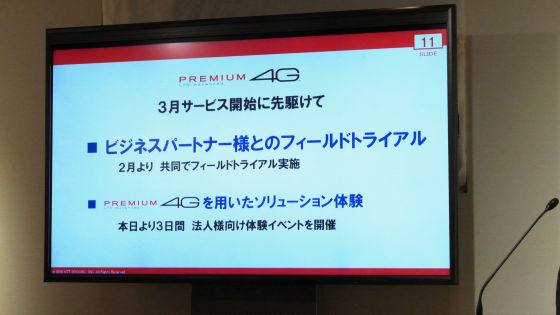
Experience spot of ultra high speed 262.5 Mbps will be opened in Tokyo, Nagoya and Osaka.

Although it is currently 225 Mbps, we plan to realize over 300 Mbps in FY 2016, and aim to start 5 G service around 2020.
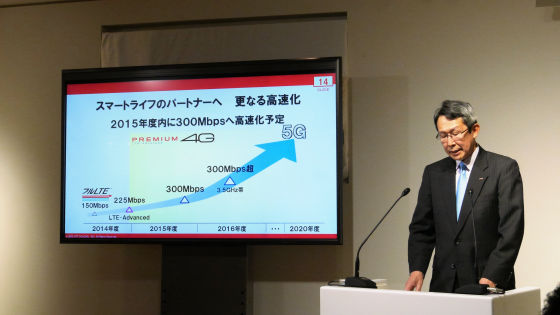
DoCoMo is aiming not only to realize speed, but also to realize three of "the latest network leading technology innovation" "simple network to evolve service" "balanced and efficient network" .
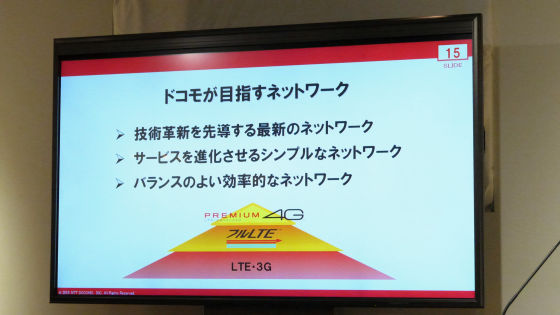
I finished my presentation and I got a question and answer here.
Question:
Currently there is no smart smartphone compatible with LTE-Advanced. Competitors are also working on LTE-Advanced, but they are not very talked about, and I do not think that it will echo at the current timing even if appealing speeding up. Why did you start PREMIUM 4G now?
answer:
Full LTE realizes 150 Mbps with a bandwidth of 20 MHz, but LTE-Advanced is over that speed. LTE-Advanced is not only "high speed" but also the latest technology realizing unprecedented "comfort" released together with the appearance of LTE category 6 standard terminal, so we will evolve the network in the future It is considered to go. As the day of service closing is coming soon, we have been able to provide opportunities to experience in fact, so I decided to make such a presentation.
Question:
If the network speeds up so far, is not it suitable for smartphones and tablets? There are also IOTs etc. at the moment, but how will the network be improved such as diversification of communication modules? What is the prospect of technology development for 5G?
answer:
First of all, it is about acceleration. There are two aspects of LTE-Advanced: "domestic highest speed" and increasing the capacity of the place where traffic concentrates by taking advantage of its capabilities. From now on, in addition to the need to "want to communicate at high speed", it is important to respond to the need to make communication more pleasant by utilizing limited technology even in areas where traffic concentrates It is. We plan to improve the network so that we can provide customers with comfortable communication and a well-balanced network anytime, anywhere, while using the "maximum speed" communication well.
As for 5G, in fact there is an important technology leading to 5G in the technology used as PREMIUM 4G this time. Carrier aglication is one of them. It is the point of 5 G that how to combine various frequencies further and to overlap. Also, it is necessary for MIMO and advanced usage to raise the capacity. We will also maintain inter-cell interference according to the crowded condition of different traffic.
Question:
Although there was a schedule for a demonstration for a corporation in a presentation, is it supposed to be for a corporation? How about the number of base stations?
answer:
This time the point of PREMIUM 4G is at 225 Mbps, as there is a router type as a Wi - Fi station, I think that affinity with PC is also high. Since there are various usage methods, I am thinking that I want to be used by corporate users beforehand and to evolve.
The number of base stations is currently under consideration. Because network traffic is living things, the situation where traffic concentrates is changing. In order to pursue the comfort of the area where traffic concentrates, PREMIUM 4G wants to make aggressive plan for FY 2003, looking at the traffic situation of that area.
Question:
Is there a population coverage rate at the time of starting? Where can I use it?
answer:
PREMIUM 4G does not look like "population coverage rate". The service area to be provided will beNTT docomoIt is scheduled to be released on the website.
Question:
Add - on cell is used, but is it changing the network?
answer:S
We do not change the network. We have been using a centralized control mechanism as C-RAN, but this time we will use advanced-C-RAN as a full LTE 1.7 GHz band, using add-on cell technology and adding small cells under it is.
Question:
Originally LTE-Advanced was scheduled to go down to 1 Gbps maximum, but as planned 1 Gbps aim to go 5 G without aiming?
answer:
Whether it is currently under consideration is undecided. In order to realize 1 Gbps, it is necessary to collect 20 M component carriers by roughly 100 M, so I think that we should prepare in the middle of heading for 2020 while doing various efforts.
Question:
About area expansion. Although it is said that it is mainly in urban areas, will not it deploy to cities where traffic is not congested?
answer:
It plans to develop it properly where necessary. With today's technology we can also deliver 150 Mbps and I would like to offer full LTE first and I think that it would be better to introduce LTE-Advanced in that deployment. As the network's capabilities have increased, there are places where we can provide sufficient performance, speed and comfort with conventional full LTE, so while watching the situation. I think that if you have advanced C - RAN you can respond to the necessary place immediately.
At the venue, the maximum speed of 225 Mbps was actually realized, and there was a demonstration to feel the speed.
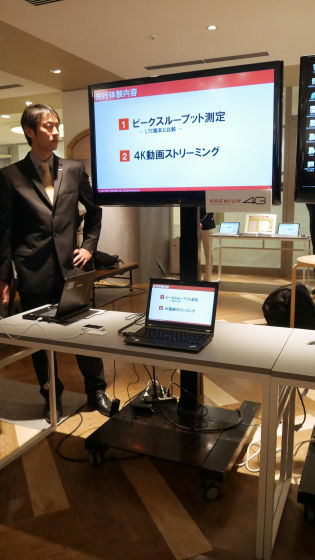
The screen on the left screen measures PREMIUM 4 G and the screen on the right measures the speed of docomo LTE.
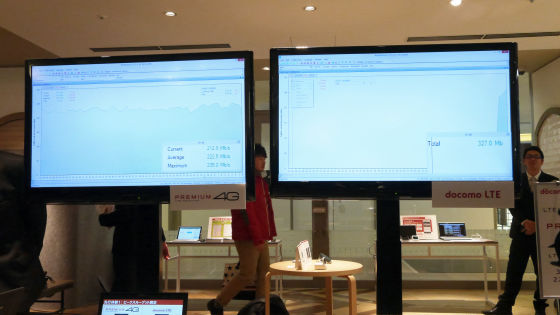
First of all PREMIUM 4G.
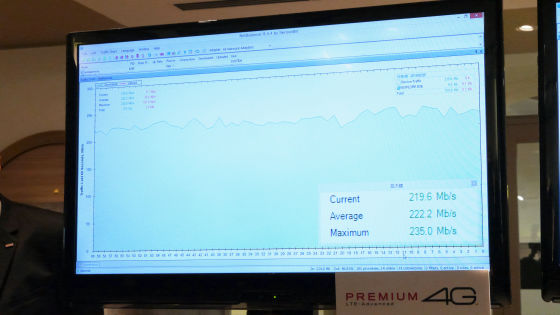
Looking at the lower right corner of the screen, the current speed is 224.7 Mbps, the average speed is 223.3 Mbps, the maximum speed is 235 Mbps, and there is more than the touch speed of "maximum speed 225 Mbps".
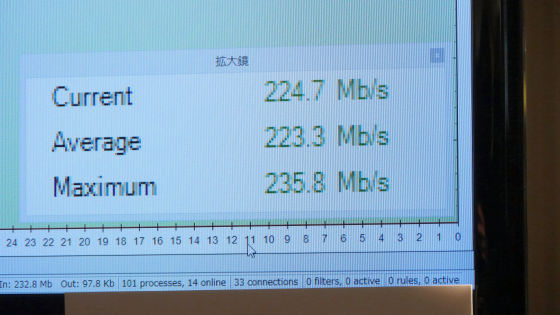
On the other hand, this is docomo LTE measurement screen.
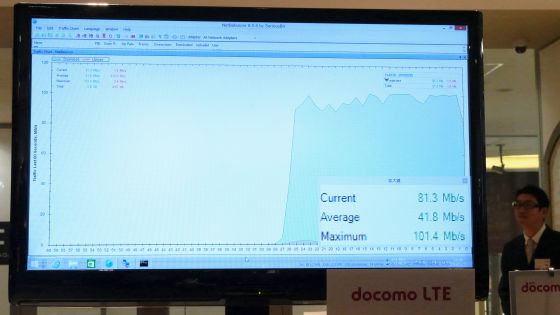
The current speed is 96.8 Mbps, the average speed is 48.0 Mbps, the maximum speed is 101.4 Mbps, and you can see that PREMIUM 4 G is recording the maximum speed more than doubled.
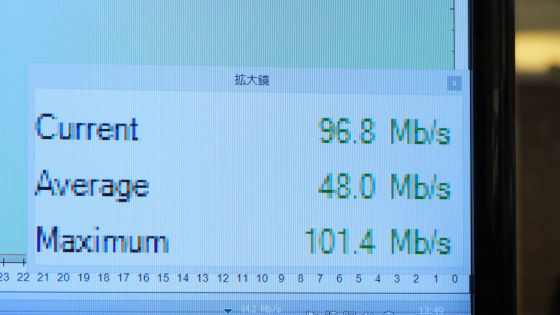
Subsequently, a demonstration of 4K streaming video playback with 4 times the amount of full high vision data.
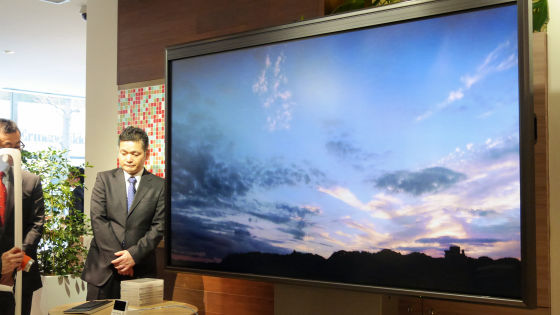
When you display 4K movies on doc 844 inchdisplay with "PREMIUM 4G", it feels like this - YouTube
HW - 02G is placed next to a huge display of 84 inches, and it is playing with kore.
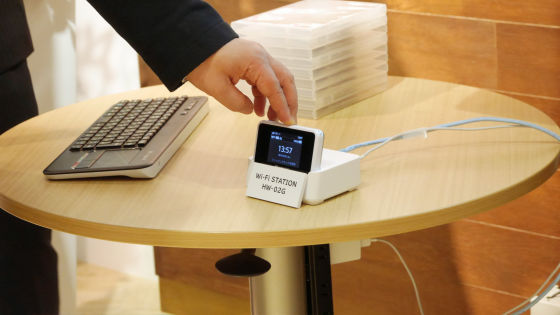
Although there is a bit of chaotic, streaming video was playing without stopping even on the large screen of 84 inches.
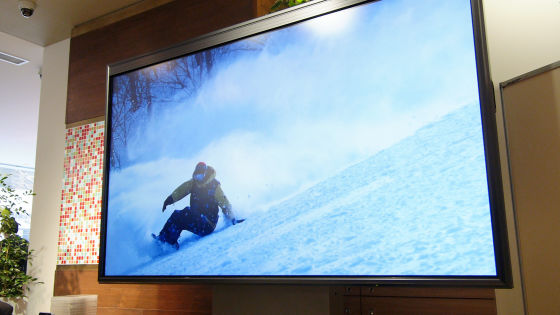
Related Posts:
in Coverage, Posted by darkhorse_log
